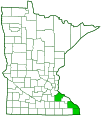Christmas fern
(Polystichum acrostichoides)
Conservation • Wetland • Description • Habitat • Ecology • Use • Distribution • Taxonomy
Description |
||
|
||
Height |
||
4″ to 30″ |
||
Flower Color |
||
|
||
Similar Species |
||
Habitat |
||
Mesic hardwood forests on north-facing or east-facing river bluffs. |
||
Ecology |
||
Sporulation |
||
|
||
Pests and Diseases |
||
|
||
Use |
||
|
||
Distribution |
||||
|
Sources |
|||
| 3/23/2023 | ||||
Nativity |
||||
Native |
||||
Occurrence |
||||
|
||||
Taxonomy |
|||
| Kingdom | Plantae (Plants) | ||
| Division | Tracheophyta (Vascular Plants) | ||
| Subdivision | Polypodiophytina | ||
| Class | Polypodiopsida (ferns) | ||
| Subclass | Polypodiidae (leptosporangiate ferns) | ||
Order |
Polypodiales | ||
| Suborder | Polypodiineae (eupolypods I) | ||
Family |
Dryopteridaceae (shieldfern) | ||
Subfamily |
Dryopteridoideae | ||
Genus |
Polystichum (shield ferns) | ||
Subordinate Taxa |
|||
|
|||
Synonyms |
|||
Polystichum acrostichoides var.acrostichoides Polystichum acrostichoides var. lonchitoides Polystichum acrostichoides var. schweinitzii |
|||
Common Names |
|||
Christmas fern dagger fern |
|||
Visitor Photos |
|||||
Share your photo of this plant. |
|||||
| This button not working for you? Simply email us at info@MinnesotaSeasons.com. Attach one or more photos and, if you like, a caption. |
|||||
|
|||||
MinnesotaSeasons.com Photos |
|||||
Plant |
|||||
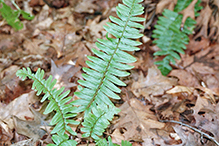 |
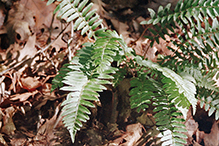 |
||||
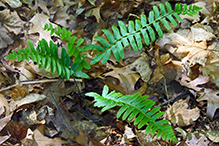 |
|||||
Frond |
|||||
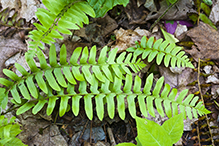 |
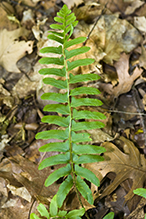 |
||||
Pinnae |
|||||
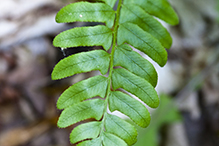 |
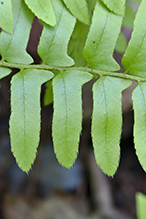 |
||||

Slideshows |
||
| Christmas Ferns Andree Reno Sanborn |
||
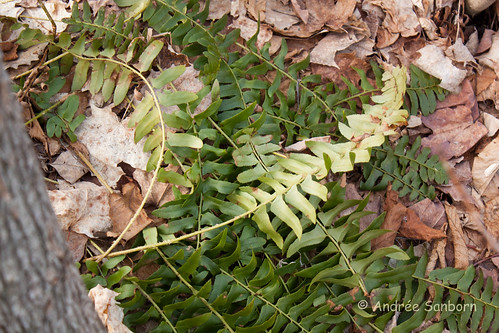
|
||
About
Polystichum acrostichoides The only evergreen fern in Vermont forests. |
||

Visitor Videos |
|||
Share your video of this plant. |
|||
| This button not working for you? Simply email us at info@MinnesotaSeasons.com. Attach a video, a YouTube link, or a cloud storage link. |
|||
Other Videos |
|||
| Hardy Evergreen Ferns - Millie Davenport clemsonpsa |
|||
About
Uploaded on Aug 19, 2009 Hi, I am Millie Davenport, a horticulture extension agent with the Clemson University Home and Garden Information Center. Today we are looking at Hardy Evergreen Ferns. We are here in the South Carolina Botanical Gardens and we are going to look at a few evergreen ferns. Now, when we think of evergreen, we think of plants usually like our trees and shrubs that hold their foliage for 2 to 3 years. Well, with evergreen ferns it is a little different. They actually will hold their foliage through the winter months and then that foliage will actually die back as spring comes on and that is when the new foliage will come on. Now, the first fern we are going to look at is a native fern and it is the Christmas Fern (Polystichum acrostichoides). The Christmas Fern gets its common name from a couple of different stories. There are three different stories that I have heard about this common name. The first one is if you look at the pinnae or the actual leaflets on the frond, they look like a Christmas stocking or a winter sleigh. The other story is that this is one of the few things that is green at the time of Christmas. And the other story, which I preferred and liked the reason for this name, is that the early settlers of North America used the Christmas Fern to decorate during the holiday season. The Christmas Fern has a classic fern shape with these really nice, arching branches. And the fronds themselves will reach about 1 to 2 feet long and the widest parts of the frond is in the middle. You will see that it is more narrow toward the bottom and more narrow at the tip. It does have a clumping habit and it does send out new rhizomes where new plants come up. With each new rhizome there is an opportunity for digging up that plant and relocating it to multiple it in your garden. So, thats a great plus with this plant in your landscape. The Christmas Fern prefers a shady location with moist, well-drained soil. The nice thing about it, is that it will tolerate a drought once it is established. We are looking at a different species of the genus Polystichum. This is Polystichum polyblepharum. This is native to Japan and Korea and the common name is Japanese Tassel Fern. The species name polyblepharum means many eyelashes. And if you look at the rachis or the midrib of the frond, you will see lots of little hairs that are called scales on this frond. And they kind of look like eyelashes, so that is where that name comes from, as well as down on the stipe, which is the bottom portion of the frond, you will see lots of little hairs or scales, as they are called. The Japanese Tassel Fern does grow in clumps and we call them a crown. And you can see here there is a large crown where the fronds are coming from. You can actually see these really nice, cute little fiddleheads coming up from the crown. And this is where your new fronds come from. The fronds on this plant reach 1 to 2 feet long and they have a nice glossy green, dark foliage to them. The fronds can reach up to 10 inches wide, so you get really large fronds with this particular fern. The kind of glossy shimmer to these fronds make it really nice mixed amongst your hosta garden or shade garden in your landscape. We are looking at another plant native to Japan. And this is Cyrtomium falacatum, Japanese Holly Fern. It gets the name Holly Fern for the shape of its pinnae or leaflets on the fronds. The fronds are actually very leathery and coarse textured. Now, we just looked at the Japanese Tassel Fern that has a really fine texture to it and also another leathery kind of leaf to it. Both the Tassel Fern that we just looked at and the Holly Fern, because they have the leathery foliage it makes them very tolerant of dry conditions. So, that is nice for our dry conditions we have in the summer time in South Carolina. The Holly Fern has a really nice crown shape to it as well with these really large arching fronds coming out that reach about 1 to 1 ½ ft long. And the actual fronds themselves will reach 4 to 7 inches wide. So, they have a lot of width to the fronds. So, this is going to add a lot of coarse texture to your shade garden. These evergreen ferns are easy to grow, relatively pest free and even deer resistant. They just need a shady location with a moist, well-drained soil. And, they will add a lot of great interest with their different textures and leaf colors in your shade garden. For more information on gardening, landscaping, insect and disease problems on your plants, visit the Home & Garden Information Center web site at www.clemson.edu/hgic. |
|||
| Mark Warren - Christmas Fern Becky Butler |
|||
About
Published on Aug 7, 2013 Mark Warren (of Medicine Bow, Dahlonega, GA) talks about Christmas Fern. |
|||
| Christmas Ferns (Polystichum Arostichoides) wvoutdoorman |
|||
About
Published on May 1, 2012 Christmas Ferns (Polystichum Arostichoides) |
|||
| 5 Christmas Fern.wmv waterdog172 |
|||
About
Uploaded on Oct 13, 2011 New River State Park Wagonr Access Fern Nature Trail 2 miles. |
|||

Visitor Sightings |
|||||
Report a sighting of this plant. |
|||||
| This button not working for you? Simply email us at info@MinnesotaSeasons.com. Be sure to include a location. |
|||||
|
|||||
MinnesotaSeasons.com Sightings |
|||||
|
|||||

|
Created: Last Updated: © MinnesotaSeasons.com. All rights reserved. |
